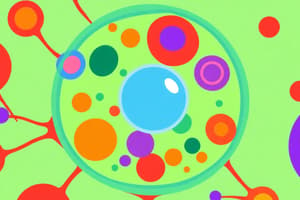Podcast
Questions and Answers
Which type of transport requires cellular energy?
Which type of transport requires cellular energy?
- Simple diffusion
- Passive transport
- Active transport (correct)
- Facilitated diffusion
Passive transport moves particles from an area of high concentration to an area of low concentration.
Passive transport moves particles from an area of high concentration to an area of low concentration.
True (A)
What is the role of spindle fibers during cell division?
What is the role of spindle fibers during cell division?
They help in the separation of sister chromatids.
During cell division, sister chromatids are connected by the ______.
During cell division, sister chromatids are connected by the ______.
Match the following terms with their descriptions:
Match the following terms with their descriptions:
Flashcards
Passive Transport
Passive Transport
Movement of particles across a cell membrane without using energy from the cell.
Active Transport
Active Transport
Movement of particles across a cell membrane that uses energy from the cell.
Cell Membrane
Cell Membrane
The thin, flexible barrier around a cell that regulates what enters and leaves the cell.
Diffusion
Diffusion
Signup and view all the flashcards
Osmosis
Osmosis
Signup and view all the flashcards
Study Notes
Biology Midterm - Multiple Choice
-
Data Types:
- Qualitative data: Measurements of characteristics like seedling height
- Quantitative data: Numerical measurements
- Descriptive data: Information about the experiment
- Theoretical data: Explanations about the experiment's methods
-
Scientific Theory:
- Biogenesis: The theory that living things come from other living things
- Spontaneous generation: The disproven theory that life can arise from non-living matter
- Scientific method: Systematic procedures for research
- Botany: The study of plants
- Peer-reviewed: Scientific papers reviewed by experts before publication
- Published works: Scientific articles that are made publicly available
-
Variables:
- Constant variable: A variable kept the same throughout the experiment
- Independent variable: The variable being changed in the experiment
- Dependent variable: The variable being measured in the experiment
- Changing Variable: The Independent Variable
- Constant variable: The variable that remains the same throughout the experiment.
-
Biological Concepts:
- Homeostasis: The maintenance of a stable internal environment in living organisms
- Metabolism: The chemical processes in living organisms
- Growth: Change in size or shape of an organism
- Development: The process by which an organism changes over time
-
Cell Theory Components:
- All cells come from pre-existing cells
- Cells are made up of mostly empty space
-
Atomic Structure:
- Nucleus: Center of the atom, containing protons and neutrons
- Protons: Positively charged particles
- Neutrons: Neutral particles
- Electrons: Negatively charged particles
- Atomic Number: Number of protons in an atom
- Atomic Mass: Sum of protons and neutrons in an atom
-
Periodic Table Relationships:
- Valence electrons: Electrons in the outermost shell of an atom
- Alkali metals: Elements in Group 1 of the periodic table, with one valence electron
- Energy levels: The levels where electrons are located in an atom
-
Atomic Mass:
- Determined by calculating the number of protons and neutrons.
-
Element Identification:
- Elements are identified by their atomic number.
-
Microscopes:
- Total magnification of a microscope: Calculated by multiplying the magnification of the eyepiece by the magnification of the objective lens
-
Cellular Components:
- Cell membrane: surrounds the cell.
- Prokaryotic cells have no nucleus, which is a difference from eukaryotic cells.
- Organelles are specialized structures found inside the cell, that perform specific functions
- Vacuole: Storage space inside cells
- Chloroplasts: Perform photosynthesis
- Mitochondria: Generate energy for cells
-
Photosynthesis:
- Equation: Light + Carbon Dioxide + Water → Sugar + Oxygen
- Chlorophyll: Important pigment in photosynthesis; absorbs sunlight
-
Cell Transport:
- Passive transport: Movement of molecules from high to low concentration
- Facilitated diffusion: Movement of molecules across a membrane with the help of proteins
- Active transport: Movement of molecules from low to high concentration, requiring energy
- Endocytosis: Taking large molecules into the cell
- Exocytosis: Releasing large molecules from the cell
- Osmosis: Movement of water across a membrane
- Hypertonic: Solution with high solute concentration
- Hypotonic: Solution with low solute concentration
- Isotonic: Solution with equal solute concentration
-
Mitosis:
- Cell division
- Prophase, Metaphase, Anaphase, Telophase: Stages of mitosis
Studying That Suits You
Use AI to generate personalized quizzes and flashcards to suit your learning preferences.




